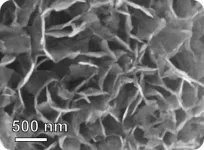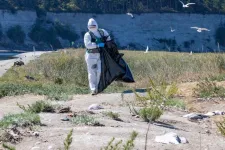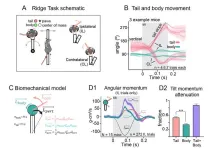Detecting evidence of lung cancer in exhaled breath
2024-11-06
(Press-News.org) Exhaled breath contains chemical clues to what’s going on inside the body, including diseases like lung cancer. And devising ways to sense these compounds could help doctors provide early diagnoses — and improve patients’ prospects. In a study in ACS Sensors, researchers report developing ultrasensitive, nanoscale sensors that in small-scale tests distinguished a key change in the chemistry of the breath of people with lung cancer. November is Lung Cancer Awareness Month.
People breathe out many gases, such as water vapor and carbon dioxide, as well as other airborne compounds. Researchers have determined that declines in one exhaled chemical — isoprene — can indicate the presence of lung cancer. However, to detect such small shifts, a sensor would need to be highly sensitive, capable of detecting isoprene levels in the parts-per-billion (ppb) range. It would also need to differentiate isoprene from other volatile chemicals and withstand breath’s natural humidity. Previous attempts to engineer gas sensors with characteristics like these have focused on metal oxides, including one particularly promising compound made with indium oxide. A team led by Pingwei Liu and Qingyue Wang set out to refine indium oxide-based sensors to detect isoprene at the level at which it naturally occurs in breath.
The researchers developed a series of indium(III) oxide (In2O3)-based nanoflake sensors. In experiments, they found one type, which they called Pt@InNiOx for the platinum (Pt), indium (In) and nickel (Ni) it contains, performed best. These Pt@InNiOx sensors:
Detected isoprene levels as low as 2 ppb, a sensitivity that far surpassed earlier sensors.
Responded to isoprene more than other volatile compounds commonly found in breath.
Performed consistently during nine simulated uses.
More importantly, the authors' real-time analysis of the nanoflakes' structure and electrochemical properties revealed that Pt nanoclusters uniformly anchored on the nanoflakes catalyzed the activation of isoprene sensing, leading to the ultrasensitive performance.
Finally, to showcase the potential medical use of these sensors, the researchers incorporated the Pt@InNiOx nanoflakes into a portable sensing device. Into this device they introduced breath collected earlier from 13 people, five of whom had lung cancer. The device detected isoprene levels lower than 40 ppb in samples from participants with cancer and more than 60 ppb from cancer-free participants. This sensing technology could provide a breakthrough in non-invasive lung cancer screening and has the potential to improve outcomes and even save lives, the researchers say.
The authors acknowledge funding from the National Natural Science Foundation of China, China’s State Key Laboratory of Chemical Engineering, the State Key Laboratory of Electrical Insulation and Power Equipment, the Shanxi-Zheda Institute of Advanced Materials and Chemical Engineering, the National Key Research and Development Program of China-Young Scientists, the Research Funds of Institute of Zhejiang University-Quzhou, and the Science and Technology Program of the Institute of Zhejiang University-Quzhou.
The paper’s abstract will be available on Nov. 6 at 8 a.m. Eastern time here: http://pubs.acs.org/doi/abs/10.1021/acssensors.4c01298
###
The American Chemical Society (ACS) is a nonprofit organization chartered by the U.S. Congress. ACS’ mission is to advance the broader chemistry enterprise and its practitioners for the benefit of Earth and all its people. The Society is a global leader in promoting excellence in science education and providing access to chemistry-related information and research through its multiple research solutions, peer-reviewed journals, scientific conferences, e-books and weekly news periodical Chemical & Engineering News. ACS journals are among the most cited, most trusted and most read within the scientific literature; however, ACS itself does not conduct chemical research. As a leader in scientific information solutions, its CAS division partners with global innovators to accelerate breakthroughs by curating, connecting and analyzing the world’s scientific knowledge. ACS’ main offices are in Washington, D.C., and Columbus, Ohio.
Registered journalists can subscribe to the ACS journalist news portal on EurekAlert! to access embargoed and public science press releases. For media inquiries, contact newsroom@acs.org.
Note: ACS does not conduct research but publishes and publicizes peer-reviewed scientific studies.
Follow us: X, formerly Twitter | Facebook | LinkedIn | Instagram
END
[Attachments] See images for this press release:

ELSE PRESS RELEASES FROM THIS DATE:
2024-11-06
A Joint research team (Prof. Jun-hee Lee, Hyun-koo Kim, Jin-Wook Hwang, Jae-Ho Chung, the Department of Thoracic and Cardiovascular Surgery, Korea University College of Medicine) Announced the world's first compartive results of single-port robotic thymectomy using the single-port robotic system.
The team compared and analyzed the perioperative outcomes of 110 cases of robotic thymectomy using the single-port robotic system and conventional video-assisted thoracic surgery(VATS) thymectomy from November 2018 to May 2024. The results showed that all robotic thymectomy performed were successfully ...
2024-11-06
One out of 100 people will experience a psychotic episode in their lifetime, and these usually appear in late adolescence or early adulthood. A Canada-US team consisting of Sylvain Bouix, from École de technologie supérieure (ÉTS), Martha E. Shenton and Ofer Pasternak, from the Brigham and Women’s Hospital (Harvard University), and René Kahn, from Mount Sinai Hospital (New York) has just received US $33 million in funding—the equivalent of CAD 45 million—over five years from the National Institute of Mental Health ...
2024-11-06
PULLMAN, Wash. – An epidemiological study found that 56% of a large breeding colony of Caspian terns died from a 2023 outbreak of highly pathogenic avian influenza at Rat Island in Washington state. Since then, no birds have successfully bred on the island, raising concerns that the outbreak may have had a significant impact on an already declining Pacific-coast population.
As part of the study, a team including Washington Department of Fish and Wildlife (WDFW) as well as Washington State University researchers also documented that the avian flu virus H5N1was transmitted to harbor seals for the first time in the northeastern ...
2024-11-06
Why do mice have tails?
The answer to this is not as simple as you might think. New research from the Okinawa Institute of Science and Technology (OIST) has shown that there’s more to the humble mouse tail than previously assumed. Using a novel experimental setup involving a tilting platform, high-speed videography and mathematical modelling, scientists have demonstrated how mice swing their tails like a whip to maintain balance – and these findings can help us better understand balance issues in humans, paving the way for spotting and treating neurodegenerative diseases like multiple ...
2024-11-06
CHAMPAIGN, Ill. — Materials scientists can now use insight from a very common mineral and well-established earthquake and avalanche statistics to quantify how hostile environmental interactions may impact the degradation and failure of materials used for advanced solar panels, geological carbon sequestration and infrastructure such as buildings, roads and bridges.
The new study, led by the University of Illinois Urbana-Champaign in collaboration with Sandia National Laboratories and Bucknell University, shows that the amount ...
2024-11-06
Vitamin D during pregnancy boosts children’s bone health even at age seven
Children whose mothers took extra vitamin D during pregnancy continue to have stronger bones at age seven, according to new research led by the University of Southampton and University Hospital Southampton (UHS).
Bone density scans revealed that children born to mothers who were given vitamin D supplements during pregnancy have greater bone mineral density in mid-childhood. Their bones contain more calcium and other minerals, making them stronger and less likely to break.
Researchers say the findings, published in The American Journal of Clinical Nutrition, reinforce the importance of ...
2024-11-06
The CRISPR molecular scissors have the potential to revolutionize the treatment of genetic diseases. This is because they can be used to correct specific defective sections of the genome. Unfortunately, however, there is a catch: under certain conditions, the repair can lead to new genetic defects – as in the case of chronic granulomatous disease. This was reported by a team of basic researchers and physicians from the clinical research program ImmuGene at the University of Zurich (UZH).
Chronic granulomatous disease is ...
2024-11-06
In a large multi-ethnic group of adults in the United States without cardiovascular disease, those with work-related stress were more likely to have unfavorable measures of cardiovascular health. The findings are published in the Journal of the American Heart Association.
For the analysis, investigators assessed data collected between 2000 and 2002 for 3,579 community-based men and women aged 45–84 years enrolled in the Multi-Ethnic Study of Atherosclerosis. Cardiovascular health was determined based on seven metrics—smoking, physical activity, body mass index, diet, total cholesterol, blood pressure, and blood glucose—with each metric contributing zero points, ...
2024-11-06
Because nitrogen fertilizers contribute to global greenhouse gas emissions, scientists are looking for ways to modify agricultural plants so that they rely on less nitrogen. In research published in New Phytologist, investigators have found that blocking a particular protein may achieve this goal in potatoes.
The protein, called Solanum tuberosum CYCLING DOF FACTOR 1 (StCDF1), binds to DNA and plays a key role in regulating tuberization in potatoes. In this latest research, investigators found that StCDF1 ...
2024-11-06
An analysis published in the Journal of Accounting Research uncovers evidence that conflicts of interest arising from commercial ties lead to bias in environmental, social, and governance (ESG) ratings.
Investigators focused on Moody’s and S&P’s acquisitions of ESG rating agencies Vigeo Eiris and RobecoSAM. Their analysis revealed that after these ESG rating agencies were acquired by Moody’s and S&P, they issued higher ratings to existing paying clients of Moody’s and S&P. Specifically, ...
LAST 30 PRESS RELEASES:
[Press-News.org] Detecting evidence of lung cancer in exhaled breath





